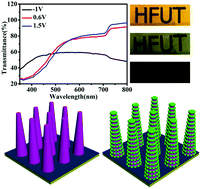Preparation of V2O5 dot-decorated WO3 nanorod arrays for high performance multi-color electrochromic devices†
Abstract
WO3 nanorod/V2O5 dot hybrid arrays have been successfully prepared by combining solvothermal and electrodeposition methods. Microstructural characterization evidences single crystallinity of WO3 nanorods decorated with V2O5 dots below 3 nm in average diameter. Electrochemical and electrochromic measurements reveal that the nanorod arrays demonstrate high transmittance modulation (57% at 776 nm), fast switching speeds (bleaching: 4.4 s and coloration: 4.8 s), multi-colors (black, green-yellow and orange-yellow) and high coloration efficiency (87.1 cm2 C−1 at 776 nm), which exhibited significantly improved electrochromic properties with superior cyclic stability compared to the individual components. Mechanistic investigation suggests that the synergistic effect between the V2O5 dots and the WO3 nanorods as well as the architecture of the aligned nanoarrays can promote the reaction dynamics and enhance the cyclic stability during the electrochromic process. The exceptional electrochromic properties of the WO3 nanorod/V2O5 dot arrays show their great potential in constructing high performance inorganic electrochromic devices for energy-saving and smart display applications.



 Please wait while we load your content...
Please wait while we load your content...